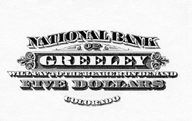|
Union
Colony Proposal
Nathan Meeker wrote an article in the New York Tribune
in December 1869 with the endorsement of the editor,
Horace Greeley that propelled the formation of Union
Colony of Colorado. He wrote, "I propose to unite
with the proper persons in establishing a colony in
Colorado Territory. A location I have seen is well
watered with streams and springs, there are beautiful
pine groves, the soil is rich, and the climate is
healthful, grass will keep stock the year round, coal
and stone are plentiful, and a well traveled road
runs through the property. The land... can be settled"...
at a cost of ..."eighteen dollars for 160 acres. The
persons with whom I would be willing to associate
must be temperance men, ambitious to establish good
society,... My own plan would be to make the settlement
almost wholly in a village, and divide the land into
lots of 10 acres and to divide these into eight lots
for building purposes and then to apportion to each
family from forty to eighty, even 160 acres adjoining
the village" for farms. The response was almost overwhelming,
before two months had passed, three thousand had responded.
A meeting was held in New York December 23, 1869 to
draw up a charter and commission a locating committee
led by Mr. Meeker, and including Henry T. West and
General R. A. Cameron. On April 12 the New York Tribune
reported the locating committee had bought 70,000
acres of railroad and government land on the Cache
a La Pouder river in Colorado, half-way between Denver
and Cheyenne.
Greeley
Settled
General Cameron proposed to name the town Meeker but
Mr. Meeker was far too modest a man to vote for naming
a town after himself. They agreed to name it Greeley
for Horace Greeley. The Union Colony of Colorado was
incorporated in April of 1870. The town was layout
in a one mile square and building of the first of
four ditches that were planned for irrigating the
farm land, was begun the first year. A total of 687
certificates were sold at $155 each which entitled
the holder to purchase one residential and one business
lot for $25-$50 in the city. It also allowed the holder
to purchase 80 acres of farm land with water rights
near the city for $75. All of the deeds included the
following temperance requirement: "And also the farther
consideration that it is expressly agreed between
the parties hereto, that intoxicating liquors shall
never be manufactured, sold or given away in any place
of public resort as a beverage on said premises; and
that in case any of these conditions shall be broken
or violated, this conveyance and everything therein
shall be null and void."
The
importance of success in irrigation to the colony
cannot be over estimated. If they had failed to develop
agriculture by irrigation there would now be no town
of Greeley. Irrigation is required in eastern Colorado
because the annual rainfall is less than 15 inches
per year. Ditch construction and irrigation framing
in the early 1870s was not widely practiced or understood.
It took a number of years building ditches, enlarging
them and learning when and how much to irrigate before
farming began to flourish. By 1889 there were 400,000
acres under irrigated cultivation.
During
the first year the rise in business property was quite
marked, but residential lot value fell off as some
moved to their farms and some left the colony. There
was not a rapid rise in farm property because grasshoppers
were a major menace and there was a shortage of irrigation
water.
|
